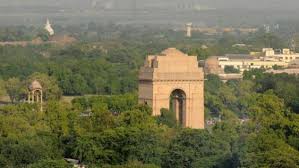New Delhi – In a bold step toward environmental innovation, Delhi’s Environment Minister Manjinder Singh Sirsa announced on Thursday that the government is planning to explore cloud seeding to curb air pollution in the national capital. This initiative is being considered for implementation on an experimental basis in May, with the goal of artificially inducing rain to clear smog and toxic particulate matter from the atmosphere.

As air quality continues to worsen, especially during summer and pre-monsoon months, cloud seeding to curb air pollution could provide short-term relief and long-term strategic direction in Delhi’s war against pollution. This article breaks down the plan, its feasibility, scientific principles, prior global usage, and the public response so far.
The Problem: Persistent and Hazardous Air Pollution
Delhi has consistently ranked among the most polluted cities in the world. Even in non-winter months, the air quality index (AQI) often exceeds 300, indicating hazardous levels. The main sources of pollution in Delhi include:
-
Vehicular emissions
-
Industrial discharge
-
Construction dust
-
Crop stubble burning (seasonal)
-
Waste incineration
-
Particulate matter from dry weather
This summer, with rising temperatures and decreased moisture in the air, authorities fear another spike in PM2.5 and PM10 levels. That’s why the government is looking at cloud seeding to curb air pollution as an emergency intervention measure.
What is Cloud Seeding?


Cloud seeding is a form of weather modification that involves dispersing substances into the air to encourage cloud condensation and rainfall. These substances, such as silver iodide, potassium iodide, or dry ice, provide nuclei around which moisture in the air can condense and form rain.
For cloud seeding to curb air pollution, the rain helps wash down airborne pollutants like sulfur dioxide, nitrogen oxide, and particulate matter, significantly improving air quality for days or even weeks.
The process is usually executed by:
-
Aircraft flying through clouds
-
Drones dispersing chemicals
-
Ground-based cannons or rockets
Delhi is considering the aerial route for this experimental trial in May.
Delhi’s Plan: Timeline and Strategy


The plan to use cloud seeding to curb air pollution is still in the feasibility study phase. The following timeline has been proposed:
-
Early April: Feasibility assessment by meteorological and scientific agencies
-
Mid-April: Tender process to select vendors and flight operators
-
Late April: Equipment readiness and pilot training
-
May (first half): Actual cloud seeding execution, based on cloud availability
Key government departments, including the Delhi Pollution Control Committee (DPCC), India Meteorological Department (IMD), and academic researchers from top scientific institutions, will collaborate on the project.
Officials are currently identifying air corridors with frequent cloud formations in May that would make cloud seeding to curb air pollution technically viable.
Why May? The Strategic Timing
May is an unusual but strategic choice for conducting a pilot of cloud seeding to curb air pollution. Here’s why:
-
Pre-monsoon Cloud Activity: Light to moderate cloud build-up begins in May, especially in Northern India.
-
Rising Pollution: May sees a spike in dust storms, vehicular emissions, and dry air.
-
Dry Spell: There’s little to no natural rain to clear pollution during this time.
-
Trial Before Monsoon: Testing now helps authorities prepare better for large-scale use later if successful.
Cloud formation will be tracked daily, and the seeding will only be conducted on days when weather conditions permit it.
Scientific Support and Technical Partners
Manjinder Singh Sirsa emphasized that the government will not proceed without scientific validation. The Ministry of Environment is consulting leading atmospheric scientists to validate the plan for cloud seeding to curb air pollution.
Delhi may collaborate with:
-
Indian Institute of Tropical Meteorology (IITM), Pune
-
Indian Meteorological Department (IMD)
-
CSIR-National Physical Laboratory
-
International experts in cloud seeding from the UAE and China
Previous international cloud seeding programs have shown encouraging results in controlling pollution, including:
-
Beijing Olympics (2008): Used cloud seeding to ensure clean air for the games
-
UAE (Ongoing): Conducts regular cloud seeding to increase rainfall and reduce dust
-
Thailand and Indonesia: Used cloud seeding to fight forest fire smoke and haze
Delhi hopes to replicate some of these successful models in a controlled, monitored environment.
Expected Benefits: Short-Term Relief, Long-Term Potential
The implementation of cloud seeding to curb air pollution could deliver measurable results almost immediately. The anticipated benefits include:
-
Immediate AQI Improvement: Experts predict 30-50% reduction in PM2.5 and PM10 after moderate rainfall.
-
Public Health Relief: Reduction in respiratory and cardiac emergencies due to cleaner air.
-
Boost to Confidence: Reassurance for residents and global observers that Delhi is taking proactive steps.
-
Scientific Benchmarking: First urban cloud seeding test solely for air pollution in India.
-
Policy Foundation: Potential to frame future emergency protocols and budget allocations.
Estimated Cost and Funding
Preliminary estimates suggest that cloud seeding to curb air pollution in Delhi could cost between ₹12 crore to ₹18 crore for a limited, three-day operation. Costs would include:
-
Aircraft and crew rentals
-
Chemical dispersal materials
-
Meteorological services
-
Safety and environmental audits
-
Ground logistics and coordination
Funding is expected to come from the Environment Department’s emergency fund and disaster management reserves. Delhi is also exploring whether the National Clean Air Programme (NCAP) can contribute.
Challenges Ahead: Feasibility and Risks
Despite its promise, cloud seeding is not a guaranteed solution. Challenges include:
-
Cloud Dependency: Requires the presence of suitable clouds with enough moisture.
-
Environmental Risks: Concerns about long-term soil and water contamination from seeding agents.
-
Technical Precision: Requires accurate weather models and skilled flight teams.
-
Public Expectation: Citizens may expect rainfall after every seeding attempt, creating pressure.
-
Limited Duration: Benefits from rainfall may last a few days, requiring follow-up interventions.
The Delhi government has assured that cloud seeding to curb air pollution will only proceed with comprehensive risk assessments and environmental clearances.
Public and Political Reactions
The announcement has sparked a mix of enthusiasm and skepticism among residents and political leaders. Environmental activists have applauded the innovation but stressed the importance of addressing root causes like vehicular emissions and construction dust.
Some opposition leaders questioned the cost-effectiveness of cloud seeding to curb air pollution, urging the government to focus on stricter enforcement of existing pollution norms.
A social media campaign under the hashtag #CleanAirWithClouds has already started gaining traction, with many Delhiites expressing hope that the skies might soon offer more than just smog.
Expert Opinions: Can Cloud Seeding Work for Delhi?
Prominent scientists and meteorologists have offered cautious optimism. Most agree that cloud seeding to curb air pollution can work in the right atmospheric conditions, but should not be viewed as a silver bullet.
Key observations include:
-
“Useful as an emergency measure but not a replacement for structural change.”
-
“Best used in tandem with other strategies like odd-even schemes and air purifiers.”
-
“Needs data-driven execution to ensure success and public confidence.”
Also Read: 500 KW Solar Energy System to be Installed on Delhi Assembly Premises
Final Word: Turning to the Skies for Cleaner Air
As Delhi prepares for another summer of rising pollution levels, the decision to test cloud seeding to curb air pollution could be a game-changer. It represents both a symbolic and strategic move that places Delhi on the global map of climate innovation.
While challenges remain, the willingness to embrace science-driven solutions, especially when the stakes are high, is commendable. If successful, the May trial may lay the groundwork for more frequent and targeted use of cloud seeding during pollution peaks.

